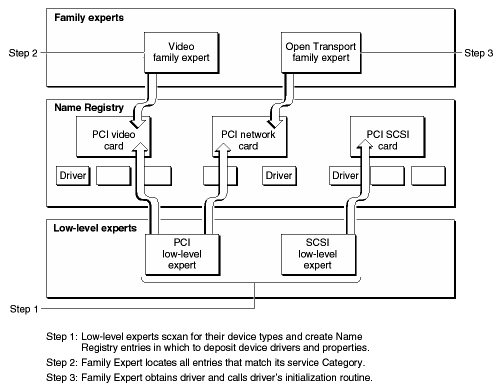PATH
The Mac OS Name Registry is a database of system information. The native I/O framework uses the Registry as a general storage and retrieval mechanism for family experts and low-level experts. Device scanning code and the Name Registry help separate system initialization and device driver initialization in a well-defined way, as illustrated in Figure 6-2. The Name Registry is more fully described in Name Registry.
Figure 6-2 Typical role of the Name Registry

Although it does not drive the startup process, the Name Registry assists system startup by providing a structure for storing information. It does this in several ways:
These processes are marked by steps in Figure 6-2. In Step 1, low-level experts scan the PCI bus for their device types and create name entries in the Name Registry that identify device properties and contain device drivers. In Step 2, family experts locate all name entries that match their service categories. In Step 3, family experts obtain device drivers and call the drivers' initialization routines.
To make driver design easier, the Name Registry lets all types of device drivers be written identically, whether they are located in expansion ROMs, system firmware, or elsewhere. Drivers can expect basic hardware information to be available in the Registry and are not required to locate or hard code this data.
The Name Registry supports a comprehensive driver replacement capability, described in Finding, Initializing, and Replacing Drivers. All device entries and their corresponding code drivers exist in the device portion of the Name Registry and are available for this process.